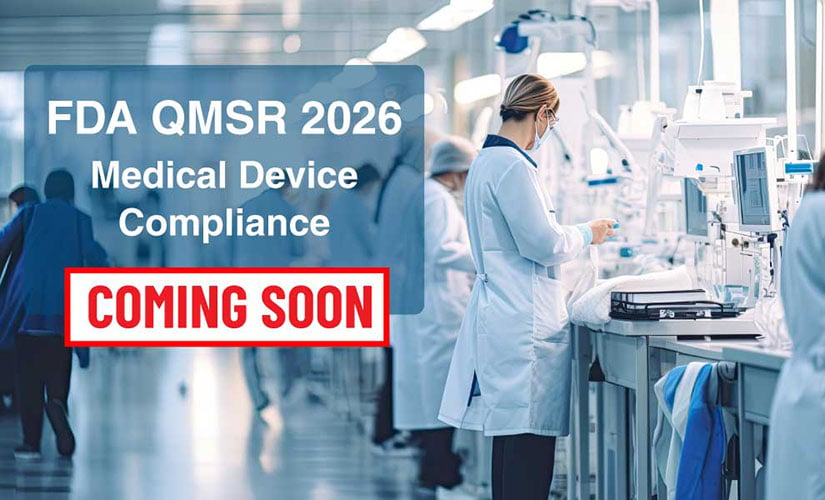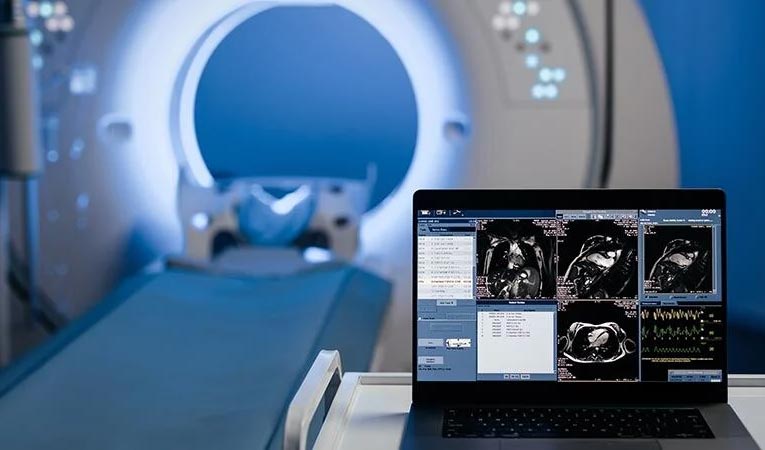Share this
FDA QMSR 2026: Guide to the New 21 CFR 820

by QT9 QMS Software on August 26, 2025
For decades, the U.S. Food and Drug Administration’s (FDA) Quality System Regulation (QSR) has served as the cornerstone of medical device quality regulations in the United States. Now the landscape is shifting with the imminent arrival of FDA’s new Quality Management System Regulation (QMSR), which aligns the U.S. regulatory framework more closely with international standards. The FDA QMSR 2026 becomes effective in a mere six months: Are you ready?
This comprehensive guide will delve into the upcoming changes, discuss what to anticipate once the QMSR takes effect in February 2026 and outline steps you can take now to ensure you’re ready.
Contents
What is FDA Quality Management System Regulation (QMSR)
What changes can we expect with the QMSR?
Steps to ensure you're prepared for QMSR 2026
What to expect once the QMSR is effective
How QT9 QMS helps ensure QMSR compliance
What is the FDA Quality Management System Regulation (QMSR)?
The QMSR is the set of revised quality system regulations that will soon be in place for medical device manufacturing compliance in the United States, replacing the current QSR. Final publication of the revised regulations was issued by the FDA on February 2, 2024, with enforcement slated to begin in February 2026. QMSR 2026 is designed to bring FDA standards more in line with the global medical device quality system standards outlined in ISO 13485:2016.
QMSR vs QSR: Key differences
Currently, the QSR provides a framework for quality systems that govern the design, manufacture, packaging, labeling, storage, installation and servicing of finished medical devices intended for commercial distribution. It emphasizes a risk-based approach and mandates processes for corrective and preventive actions (CAPA), management responsibility, resource management and product realization.
While the QSR has served the industry well, the globalization of the medical device market and the increasing complexity of devices have necessitated a more harmonized international approach to quality management.
Key changes are outlined in the table below:
Design History File (DHF): Records that describe the design history of a finished device.
Device History Record (DHR): A record of the production history of a finished device.
Management with Executive Responsibility: The individuals with senior-level authority to establish or make changes to the quality policy.
Design & Development Files: The QMSR aligns with ISO 13485 requirements for maintaining design and development files, which are equivalent in purpose to the DHF.
Device Record: The QMSR aligns with ISO 13485 requirements for records demonstrating manufacturing and production history of a device.
Top Management: A broader term that refers to the person or group that directs and controls an organization at the highest level, giving this group greater responsibility for the QMS.
What changes can we expect with the QMSR?
The most significant change introduced by the QMSR is its direct incorporation of the international medical device quality standard, ISO 13485:2016, with minor modifications. This means that medical device manufacturers should adapt their quality systems to meet the requirements outlined in ISO 13485: 2016.
While the underlying principles of quality management remain, the QMSR introduces several key shifts and areas of increased emphasis:
Focus on product lifecycle
Like ISO 13485:2016, the new QMSR will emphasize a total lifecycle approach that involves all stages of a medical device, from initial concept and design through post-market surveillance and eventual disposal. This necessitates a more holistic approach to quality throughout the entire product journey.
Stronger emphasis on risk management
While the current QSR incorporates risk management, the new QMSR elevates its importance and integrates it more thoroughly into various quality system processes. This includes risk identification, analysis, evaluation, control and monitoring throughout the product lifecycle.
Enhanced requirements for documentation and records
The QMSR aligns with the more stringent documentation and record-keeping requirements of ISO 13485:2016. This includes detailed documentation of processes, procedures, responsibilities and records to demonstrate compliance and traceability.
Increased focus on supplier management
QMSR places greater emphasis on the control and monitoring of suppliers and external providers. Manufacturers will need to establish robust processes for supplier qualification, evaluation and ongoing monitoring to ensure the quality of externally sourced materials and services.
Clarification of management responsibilities
The new QMSR more clearly defines the responsibilities of top management in establishing, implementing and maintaining a quality management system. This includes a commitment to quality, establishing quality objectives and ensuring the availability of necessary resources.
Emphasis on competence, awareness and training
The QMSR, through its alignment with ISO 13485:2016, underscores the importance of employee competence, awareness of quality objectives and the provision of adequate training to ensure that personnel are capable of performing their assigned tasks effectively.
More explicit requirements for post-market surveillance
The QMSR reinforces the need for robust post-market surveillance activities, including the collection and analysis of data on device performance, complaints handling and reporting of adverse events. This feedback loop is crucial for identifying potential issues and implementing corrective actions.
Alignment with international standards
The most significant overall change is the move towards harmonization with an internationally recognized standard. This will facilitate global trade and reduce the burden of compliance for manufacturers selling devices in multiple markets.
Steps to ensure you're prepared for QMSR 2026
The February 2026 effective date is right around the corner. If you haven’t begun to prepare, all is not lost. Here are actionable steps your organization can take right now:
-
Conduct a gap assessment: The first and most critical step is to conduct a comprehensive gap assessment of your current QSR-compliant quality management system against compliance requirements put forth by the QMSR. Identify areas where your current processes and documentation fall short of the new requirements.
-
Develop a transition plan: Based on the findings of your gap assessment, develop a detailed transition plan with clear timelines, responsibilities and resource allocation. This plan should outline the specific actions needed to bring your quality system into compliance with the QMSR by next February.
-
Update documentation: A significant portion of the transition will involve updating your existing documentation, including quality manuals, procedures, work instructions and forms. Pay close attention to areas such as risk management, supplier management and post-market surveillance.
-
Implement necessary process changes: Identify and implement any necessary changes to your existing processes to meet the requirements of the QMSR. This may involve establishing new processes or modifying existing ones.
-
Provide employee training: Ensure that all relevant personnel receive adequate training on the new QMSR requirements and the changes being implemented within your organization. This training should cover the principles of QMSR and specific updates to your quality system.
-
Review and update supplier agreements: Re-evaluate your supplier agreements to ensure they align with the enhanced supplier management requirements of the QMSR. This may involve incorporating new quality requirements and monitoring processes.
-
Strengthen your risk management processes: Review and enhance your risk management processes to ensure they are fully integrated into all aspects of your quality management system, as emphasized by QMSR.
-
Conduct internal audits: Once you have implemented the necessary changes, conduct thorough internal audits to assess the effectiveness of your updated quality management system and identify any remaining gaps.
What to expect once the QMSR is effective
Once the QMSR becomes effective in February 2026, several key changes will impact medical device manufacturers:
-
FDA inspections will focus on QMSR requirements: FDA inspections will be conducted based on the requirements of the QMSR, which are largely based on ISO 13485:2016. Inspectors will be looking for evidence of compliance with these new requirements.
-
Potential for increased scrutiny: In the period following initial implementation of the QMSR, manufacturers may experience increased scrutiny from the FDA as the agency assesses industry-wide compliance with the new requirements.
-
Importance of maintaining certification: For manufacturers who are already ISO 13485 certified, maintaining that certification will be a significant advantage in demonstrating compliance with the QMSR, however, ISO 13485 certification does not equal automatic QMSR compliance.
-
Focus on continuous improvement: The QMSR, like ISO 13485:2016, emphasizes the importance of continuous improvement within the quality management system. Manufacturers will need to demonstrate ongoing efforts to enhance their processes and product quality.
How QT9 QMS helps ensure QMSR compliance
Implementing and maintaining a QMS that aligns with the new QMSR can be a complex undertaking. A robust quality management software solution, like QT9 QMS, can provide significant assistance.
QT9 QMS is a comprehensive platform designed to streamline and automate various aspects of your quality management system, helping you to efficiently meet the requirements of ISO 13485:2016 and the upcoming QMSR. Here’s how QT9 QMS can help your organization prepare:
-
Document Control: QT9 QMS provides a centralized and secure system for managing all your quality-related documents, ensuring that the latest versions are always accessible and that document changes are controlled and approved.
-
Risk Management: Our QMS software includes robust risk management tools to help you identify, assess, control and monitor risks throughout the product lifecycle.
-
CAPA Management: QT9 QMS streamlines the entire CAPA process, from identifying nonconformities and initiating investigations to implementing corrective and preventive actions and verifying their effectiveness.
-
Supplier Management: QT9 QMS software offers features for managing your suppliers, including tracking supplier information, conducting evaluations and managing approved supplier lists.
-
Employee Training: QT9 QMS allows you to manage employee training records, track competencies and ensure that all personnel have the necessary training to perform their jobs effectively.
-
Audit Management: Our software facilitates the planning, scheduling, execution and reporting of internal and external audits, helping you to assess the effectiveness of your quality management system and identify areas for improvement.
-
Nonconformance Management: QT9 QMS provides a system for recording, investigating and managing nonconformances, ensuring that issues are addressed promptly and effectively.
-
Complaint Handling: The software includes a dedicated module for managing customer complaints, from initial receipt to investigation and resolution, supporting your post-market surveillance activities.
-
Management Review: QT9 QMS Management Review module streamlines the data and reports necessary to ensure that top management is actively involved in the oversight and improvement of the quality management system.
-
Compliance with ISO 13485:2016: QT9 QMS is designed with the requirements of ISO 13485:2016 in mind, providing a framework that helps you establish and maintain a compliant quality management system that will meet the expectations of the QMSR.
Conclusion
The transition to the new QMSR represents a significant shift in the regulatory landscape for medical device manufacturers in the United States. While the underlying principles of quality management remain consistent, the incorporation of ISO 13485:2016 necessitates a proactive and comprehensive approach to preparation.
By understanding the changes, taking concrete steps now and leveraging the power of modern quality management software like QT9 QMS, your organization can navigate this transition smoothly, ensure continued compliance and ultimately contribute to the safety and effectiveness of your medical devices.
You might also like...

ISO 13485 Software Guidelines

FDA 21 CFR Part 820 & ISO 13485 Harmonization for Med Devices
FAQ: FDA QMSR 2026
The FDA Quality Management System Regulation (QMSR) is the new U.S. medical device quality standard that replaces the long-standing Quality System Regulation (QSR, 21 CFR Part 820). Published on February 2, 2024, it becomes enforceable in February 2026 and is aligned with ISO 13485:2016 to harmonize U.S. requirements with international standards.
The FDA will begin enforcing QMSR requirements in February 2026. Medical device manufacturers have two years from publication to transition their quality systems from QSR to QMSR compliance.
The QMSR incorporates ISO 13485:2016, making it more internationally harmonized than the QSR. Key differences include:
-
Lifecycle approach to medical device quality
-
Stronger integration of risk management
-
Expanded documentation and record-keeping requirements
-
Increased supplier and external provider oversight
-
Clearer management accountability
-
More robust employee training and competence requirements
-
Enhanced post-market surveillance processes
Inspections will focus on QMSR-based requirements, aligned with ISO 13485:2016. Manufacturers should expect FDA inspectors to review risk management, supplier oversight, documentation, and post-market surveillance with increased scrutiny during the transition period.
Not automatically. While ISO 13485 certification gives manufacturers a strong foundation, FDA QMSR compliance requires additional steps to meet U.S.-specific regulatory expectations. ISO 13485 certification helps but is not a substitute for full QMSR alignment.
Share this
- QT9 QMS (32)
- QT9 ERP (22)
- QT9 MRP (14)
- Company News (10)
- Medical Device (8)
- Pharma (7)
- MRP Manufacturing (6)
- QMS Manufacturing (6)
- Document Control (5)
- FDA Compliance (5)
- Inventory Management (5)
- Aerospace (4)
- ISO 9001 (4)
- Life Sciences (4)
- Analytics & Reporting (3)
- Bill of Materials (3)
- CAPA (3)
- ISO Compliance (3)
- QMS Supplier Management (3)
- AS9100 (2)
- Accounting (2)
- Change Control (2)
- EBRs (2)
- ERP Life Sciences (2)
- ERP Manufacturing (2)
- FDA 21 CFR 820 (2)
- ISO 13485 (2)
- Inspections (2)
- Audit Management (1)
- Calibrations (1)
- Cosmetics (1)
- Cybersecurity (1)
- DHF/DMR/DHR (1)
- Defense (1)
- Design Controls (1)
- EMS (1)
- EU Compliance (1)
- Food & Beverage (1)
- ISO 14001 (1)
- MoCRA (1)
- QMSR (1)
- Quality Culture (1)
- Quality Events (1)
- Returns Management (1)
- Risk Management (1)
- November 2025 (8)
- October 2025 (7)
- September 2025 (8)
- August 2025 (8)
- July 2025 (6)
- June 2025 (7)
- May 2025 (5)
- April 2025 (2)
- March 2025 (4)
- February 2025 (4)
- January 2025 (6)
- December 2024 (4)
- November 2024 (4)
- October 2024 (5)
- September 2024 (3)
- August 2024 (3)
- July 2024 (3)
- June 2024 (5)
- May 2024 (2)
- April 2024 (3)
- March 2024 (3)
- February 2024 (5)
- January 2024 (1)